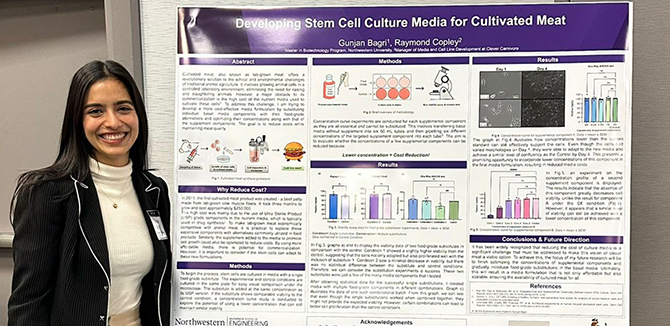Showing a Research Story
MBP students learned the importance of visual communication by presenting their work at the program's annual Fall Research Symposium

How do you communicate a feeling of suffocation caused by a life-threatening lung illness through a piece of poster board? More precisely, how can a poster explain the topic so clearly that someone unfamiliar with the illness understands it?
That was the type of challenge given to students in Northwestern Engineering's Master of Biotechnology Program (MBP) at the program's annual Fall Research Symposium.
The event is designed to raise the stakes on how students present their work. Rather than showcasing their research exclusively to their peers, the symposium gives them the opportunity to present to the MBP Industrial Advisory Board (IAB), made up of leaders in the biotech industry.
“The symposium experience is a remarkable learning opportunity,” said Iyappan Subbiah (MBP ‘24), whose poster delved into the economics and effectiveness of treatment for Acute Respiratory Distress Syndrome. “The experience of presenting our research to the MBP Industrial Advisory Board was valuable because it simulated a professional environment and provided insightful guidance for advancing our research in more impactful directions.”
Subbiah’s poster earned him one of the three top-finisher spots for the symposium, alongside fellow students Gunjan Bagri (MBP ‘24), and Xiangyu Gu (MBP ‘24). All students were required to give a 10-minute oral presentation on their research and create a poster about their work.
The oral presentation and the poster covered the same research, but each was tweaked to match the format. That was an important factor in Subbiah’s success, he said.
“What set our poster presentation apart was our use of infographics to craft a narrative and minimize unnecessary text,” said Subbiah, who conducted his research with Bill Sargent, a pharmaceutical industry veteran and adjunct professor at the Kellogg School of Management. “We created a clear, logical flow and harnessed the power of storytelling to engage our audience.”
That audience included the judges – members of the IAB whose main job with MBP is to ensure the program's lessons remain aligned with industry needs.
Bagri, who did her research on developing a more cost-effective and optimal media formulation for making cultivated meat, said the symposium was a huge reward after weeks of hard work.
“To finally be able to present to the IAB panel members was a big deal for all of us,” she said. “It was a great feeling when everyone was curious and interested in your research topic.”
Gu’s research focused on using a specially created antibody to understand more about sea urchins. The work is not just about the spiky creatures at the bottom of the ocean floor, but how improved understanding can lead to new medicines for human conditions.
Gu said he was impressed with how those viewing his poster connected the dots.
“My research has implications beyond the immediate interest of my research topic,” he said. “Many of our guests were able to associate parts of my project with their own work or something else they had crossed paths with before.”
There are more benefits to the poster portion of the symposium beyond the work itself, the students said. Those benefits are a huge strength of the event.
“The symposium goes beyond just the presentations,” Subbiah said. “It stands out for the chance to connect with both alumni and the IAB. It's truly enjoyable to interact with pioneers in various fields who share the common bond of being part of MBP.”

